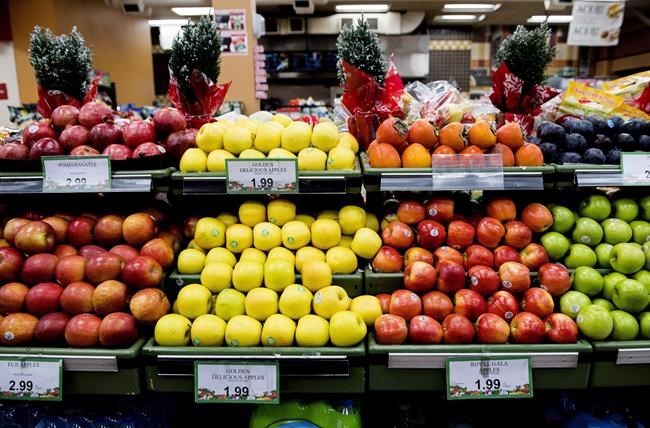HALIFAX — Food prices in Canada are expected to surge to record highs next year as ongoing pandemic-fuelled supply chain disruptions, labour market issues and adverse weather events drive up grocery bills, a new report on food prices says.
The 12th edition of Canada's Food Price Report released Thursday predicts the average Canadian family of four will pay an extra $966 for food in 2022, for a total annual grocery bill of $14,767.
That's a seven per cent increase compared with 2021 — the biggest jump ever predicted by the annual food price report.
"The era of cheap food has ended," said Sylvain Charlebois, lead author and Dalhousie University professor of food distribution and policy.
"Prices have been increasing since 2010 and the pandemic accelerated that trend."
Soaring food costs are expected to contribute to rising food insecurity in Canada, putting increasing demands on food programs intended to help, the report said.
"What is being challenged right now is food affordability," Charlebois said. "It's not going to be easy for families or anyone already struggling to put food on the table."
Food banks have already seen a rise in demand during the pandemic, and higher food prices will likely add to the pressure, said Marjorie Bencz, executive director of Edmonton's Food Bank.
“We’re concerned that if the price of food goes up more, that may mean people need the food bank more often, it may mean that more people need the food bank."
Bencz said she was also concerned how the trend will put pressure on the food industry itself that has been a kind supporter of the food bank, and on average donors.
"It could also have an impact on donors that make individual contributions to us, because again we rely on the average person and their kind support to do our work.”
A growing phenomenon related to rising food insecurity is theft from grocery stores, the report said.
"Grocers are anecdotally reporting an uptick in theft, particularly of items such as meat, cheese, over-the-counter medication and energy drinks," the report said.
Overall, food prices in Canada will increase five to seven per cent next year, the report said.
But some grocery categories will see even larger jumps in 2022.
Dairy prices are anticipated to increase six to eight per cent, a forecast that comes after the Canadian Dairy Commission recommended an 8.4 per cent increase in farm gate milk prices to offset rising production costs.
Restaurant menu prices are also going up six to eight per cent as the food service sector grapples with widespread labour market challenges and rising commercial rents, the report said.
The shortage of workers, especially back-of-house restaurant staff, is expected to drive up wages and costs and lead to higher prices, the report said.
Bakery and vegetables will both increase five to seven per cent while fruit prices will rise three to five per cent.
The smallest price increases will be in the meat and seafood aisles, with a zero to two per cent increase predicted in both categories.
Mike von Massow, a food economist and associate professor at the University of Guelph, said average consumers, who spend about 10 to 11 per cent of their income on food, could respond by choosing cheaper options of the same foods, or cutting from other parts of a household budget, but lower income households don't have that flexibility.
"If you are lower income or even food insecure, then you’re spending a much higher proportion of your income on food, and there’s just less ability to sort of let other things go."
To help manage through price inflation, he suggested people be more flexible in their buying habits by choosing foods that are in season, that can be stored better like root vegetables or frozen foods, and that don't have to be trucked as far.
On top of rising food prices, the report said consumers are likely still noticing some empty shelves in grocery stores — an issue that will persist in the new year.
Meanwhile, climate change and adverse weather events that caused price increases in 2021 are expected to continue in the new year.
Severe wildfires in British Columbia and drought conditions in the Prairies impacted bakery and meat prices this year, for example, and may continue to influence food prices in 2022.
Smaller harvests and poor crop yields will continue to raise the price of bakery items, according to the report.
"We can anticipate the ongoing effect of the continuing climate crisis and adverse weather effects on food prices," the report said. "Wildfires, record-breaking heat and drought, floods and cold fronts are becoming increasingly commonplace and affecting food prices year after year."
Several provinces are expected to see higher than average food inflation rates in 2022, including Alberta, B.C., Newfoundland and Labrador, Ontario and Saskatchewan, the report said.
This report by The Canadian Press was first published Dec. 9, 2021.
Brett Bundale, The Canadian Press



